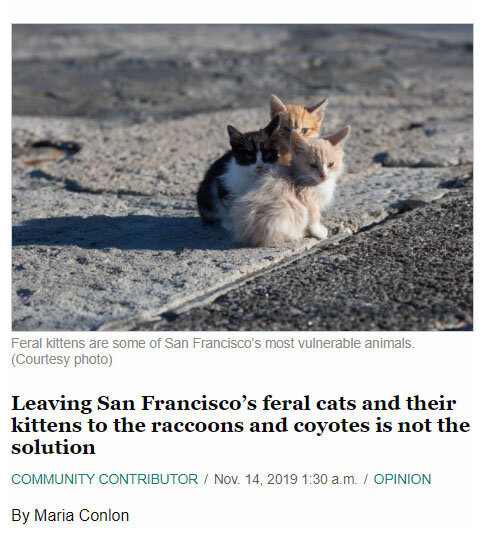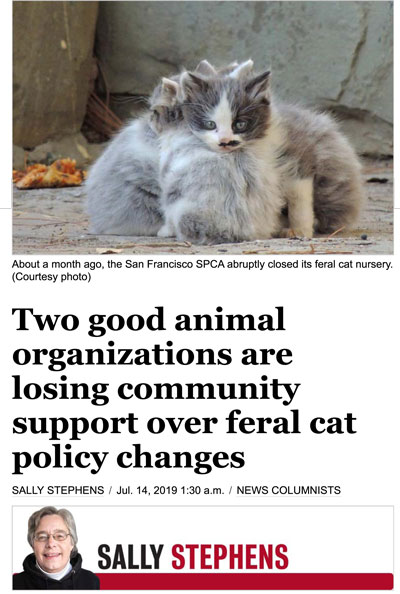San Francisco’s Animal Care and Control (ACC)
is Rejecting Lost, Abandoned and Stray Cats Found Outside
PLEASE SUPPORT REVERSING SF ACC POLICY
THAT IS COUNTERPRODUCTIVE TO HELPING
LOST CATS AND SF’S STRAY CAT POPULATION
(petition started mid August 2022)
ACC is telling people to put found cats back outside, endangering lost cats, increasing the stray population, negating TNR (trap, neuter, return) progress, and leaving cats in need on the streets.
If you care about the cats of our city and protecting our native ecosystems, please speak up and call in to the next SF Animal Control and Welfare Commission (ACWC) meeting. Commission meeting details (including previous recordings and meeting minutes) are on our SF ACWC page (which includes previous recordings and meeting minutes) and on our flyer (download PDF).
The SF ACC Petition has 26+ updates providing many details about our concerns and analysis of their new policies.
Read about community experiences:
URGENT: SF Animal Care and Control is Refusing to Help Cats in Need
San Francisco’s cats and kittens need you now!
Without notification, and in effect as of April 2019, both San Francisco’s Animal Care and Control (ACC) and SPCA have officially rolled back programs that have been in place and working for 20 years.
Some of our most vulnerable San Francisco residents - homeless (feral) mom cats with tiny nursing kittens - are at risk. SF ACC and SF SPCA have changed how they help feral moms and kittens and, in most cases, won’t send volunteer trappers who are willing to trap these moms and kittens. If the kittens survive, the mom and her kittens will be difficult to trap/neuter/return (TNR) after the kittens have been weaned, thus potentially increasing the homeless cat population, instead of steadily declining as it has over the last 20 years.
WE WANT SF ACC AND SF SPCA TO Put TRAPPERS/rescuers immediately in touch with residents who report kittens so they can go assess the situation!
Leaving San Francisco’s feral cats and their kittens to the raccoons and coyotes is not the solution
Reverse the mom cat and kitten policy at SF Animal Care and Control (SFACC) and SF SPCA. Restore protections for some of San Francisco’s most vulnerable animals: homeless kittens. They are not wildlife and need our assistance.
A September opinion article written by SF SPCA’s President Jennifer Scarlett, UC Davis’ Dr. Kate Hurley, and Alley Cat Allies’ Becky Robinson appeared in the Examiner claiming that it’s “inhumane and misguided” to bring feral cats and their newborn kittens into an animal shelter.
Two good animal organizations are losing community support over feral cat policy changes
At a recent meeting of the San Francisco Commission of Animal Control and Welfare, it was clear that a controversial change in how the San Francisco SPCA and the City’s municipal shelter, Animal Care and Control, handle feral cats is eroding support for both organizations.
More feral cats could die in San Francisco following policy change
“For over 20 years, the San Francisco SPCA and the City’s municipal shelter, Animal Care and Control, pioneered groundbreaking programs to manage feral cats. But a recent change has advocates worried that kittens will die in the wild instead of being saved and adopted into loving homes.” Sally Stephens
This is a feral mom nursing her kittens in a safe, warm foster home in San Francisco. She's eating well and so are the kittens - who are roughly 10 days old. They are safe from predators (humans, raccoons, coyotes, dogs), disease, abandonment, starvation and death. Mom will be spayed and released back to her colony once her (last litter of) kittens are weaned. Her kittens will be fortunate to have a chance at living safely in a loving home.
These teeny, vulnerable kittens are only 16 days old born of a feral mom in San Francisco. Can you imagine them attempting to survive outside? Why would anyone let that happen when there are progressive and successful programs that have been in place for over 20 years in San Francisco? Those programs have been rolled back by the SF SPCA and SF ACC.
what changed?
This article featured on Alley Cat Allies in November 2017 shared the innovative and successful program that has abruptly ended at SF SPCA. Why roll back this progressive and successful program?
When it comes to San Francisco’s feral cat policy, the claws are out. Heather Knight
The privately run San Francisco SPCA and the public Animal Care and Control SF, which is part of city government, have long called in volunteer trappers to respond to a feral cat giving birth in someone’s backyard or elsewhere within the city. Once trapped, the mom and babies would be kept together in a feral cat nursery at the SPCA until the kittens were weaned and put up for adoption. The mom cat would be spayed and released.
What changed? Why was the program shut down? Are the new staff managing the program not equipped to handle the needs of the feral moms?
SF SPCA declined to comment on this article.
Virginia Donohue, Executive Director of SF ACC, clearly doesn’t understand cat behavior, based on the following quotes from the SF Chronicle article:
Via Virginia Donohue, SF ACC
“Feral moms are basically wild animals,” Donohue said. “There’s the cat on your couch, and then there’s the feral cat who will try to kill you rather than be on your couch. When the moms are trapped in the shelter, they’re stressed, they shut down and they stop taking care of the kittens.”
OUR RESPONSE
First of all, feral moms are domesticated cats who have been abandoned outside. They are NOT wild animals and not all of them are actually feral. They bond with human caretakers although will typically not like being handled. Secondly, feral cats are afraid humans are going to try to KILL them, not the reverse, as Donohue suggested. They will hide before ever attacking. Feral mom cats can go into quiet foster homes, until their kittens are weaned. The mom cats are fed and kept safe and warm while they nurse and care for their kittens. All the perils of the outdoors are removed. Once weaned, the kittens can be adopted into loving homes and mom released back into the community after being spayed (unless it’s discovered she’s not so feral, she was just homeless).
Via Virginia Donohue, SF ACC
“That has led to disease and even death in the moms and the kittens, Donohue said. She said the mortality rate for kittens brought to the shelter under 1 month of age is 45%. Kittens brought in between 1 and 3 months, after they’re weaned but when they’re still young enough to be socialized, have a mortality rate of just 8%, Donohue said.
“I think we can all agree, 45% is not a success story,” Donohue said.
OUR RESPONSE
Where’s the data to back up these numbers? Don’t they know more kittens die outside? Did you know if a neonatal kitten comes into SF ACC with their eyes closed they will be euthanized? There’s no way to indicate if a kitten comes in with a mom or not. Many neonatal kittens will die without their moms. SF ACC’s numbers just don’t add up.
Via Virginia Donohue, SF ACC
Virginia Donohue, executive director of Animal Care and Control, explained that the change came out of discussions with veterinarians at UC Davis.
OUR RESPONSE
Did you know Dr. Hurley from UC Davis was formerly an advocate of killing feral cats to protect birds? She has admitted to personally killing thousands of cats as an Animal Control Officer in Santa Cruz. What’s the latest study? Leave them to die?
Via Virginia Donohue, SF ACC
The groups will no longer proactively trap feral cats with their kittens that are under a month old.
OUR RESPONSE
Do these agencies really think the general public who sees a kitten outside knows how old they are? Be assured, they don’t. It also means there is a chance the mom cat and her kittens will not be found after the kittens are weaned. Litters are often moved by the mom to protect them. After 3 weeks of age, the kittens are fast and have learned to hide from predators. They consider humans to be predators as they’ve not been socialized yet. If the kittens survive, males are intact and females are capable of having a litter by 6 months of age. Their mom can have another litter as well, as an unspayed female can have 3 litters per year. It means the feral cat population is once again on the increase. It had been on the decline with the policy that was in place for 20 years.





